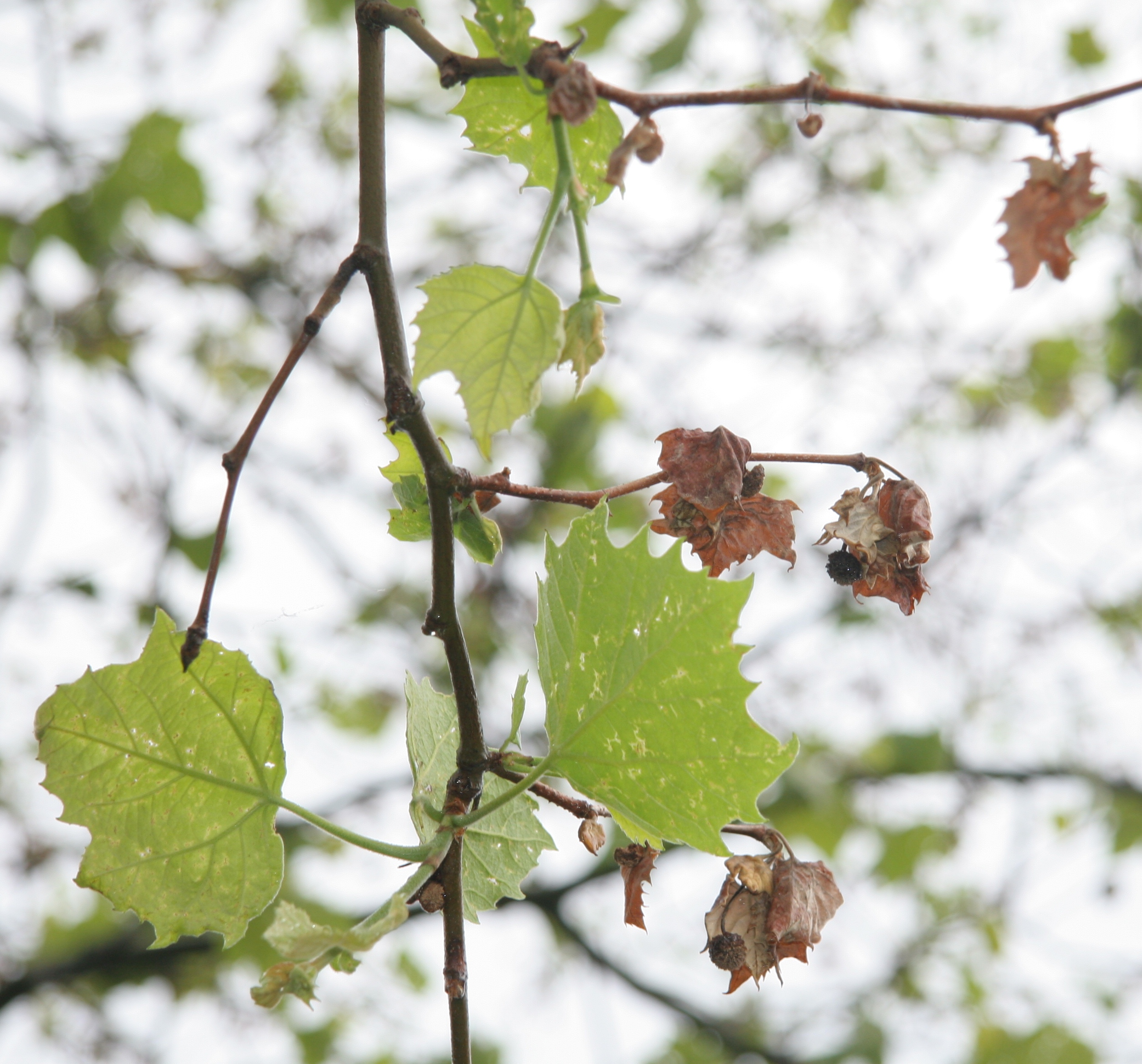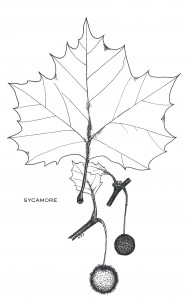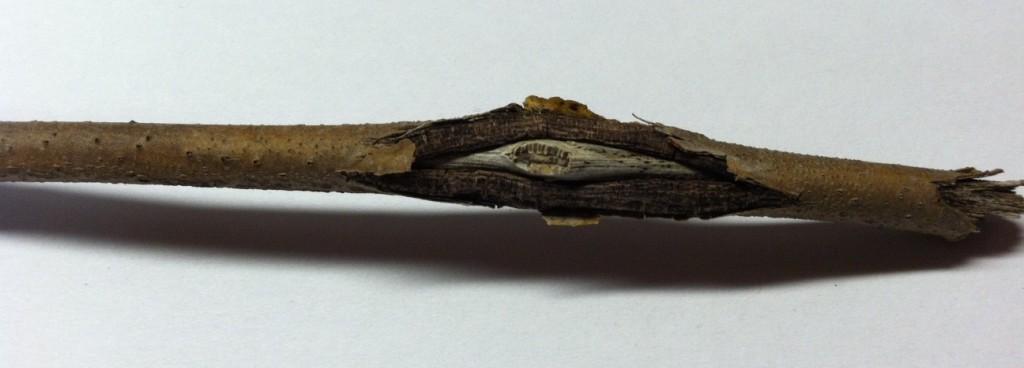Delaware Forest Service tree health update: Sycamore anthracnose
Department of Agriculture | Forest Service | Date Posted: Tuesday, May 28, 2013
Department of Agriculture | Forest Service | Date Posted: Tuesday, May 28, 2013

What’s wrong with my sycamore?
 Got a sick tree? Call the Delaware Department of Agriculture Forest Service at 302-698-4500 to get help and find out more information.
Got a sick tree? Call the Delaware Department of Agriculture Forest Service at 302-698-4500 to get help and find out more information.
American sycamore (Platanus occidentalis) is a native tree that can be affected by a fungal disease known as anthracnose. Several factors such as wet weather and lower average temperatures have combined to make this a more severe year for this condition. While many of the trees in the sycamore family are showing signs of stress, experts at the Delaware Forest Service believe that the majority of these will recover and leaf out normally as temperatures warm toward summer.
If you have a sycamore tree – or its close relative, the London or the Oriental plane tree – then you might have noticed that the tree has been affected by a type of blight known as anthracnose, which is caused by a fungus (Apiognomonia venta) that can affect the buds, leaves, shoots, and twigs. This problem is common throughout the Northeast and Mid-Atlantic states, including Delaware. Because the fungus overwinters in cankers on twigs and branches of diseased trees, some of the major contributing factors are the level of rainfall and the average daily temperatures present in the area during spring. This year, cool and wet conditions have been especially favorable to the development of anthracnose.
Signs of anthracnose
Anthracnose can be present in any one of several stages of twig and leaf development: Twig blight occurs before the leaves appear, with buds dying before they open. In this stage, small black dots (the fungus) are often seen on the bark of dead twigs. Shoot blight can happen as the young leaves start to emerge, and is often characterized by classic symptoms of small brown, wrinkled leaves (see photo). Even the fully-grown leaves that emerge can be infected by spores present in the twig cankers. This is manifested by the irregular appearance of small or large light brown dead spots along the vein. Eventually, dark brown spots on diseased areas can result in the leaves dying and falling off prematurely.
Severe cases can result in cankers appearing on large limbs, which are often killed and may need to be removed by pruning.
Mitigating factors
Fungal spores are spread by rainfall. Although fungal diseases thrive in moist conditions, early-spring temperatures are the most critical factor in disease severity. Average temperatures in the range of 50 to 55 degrees during bud break and early-leaf emergence are highly conducive to severe disease, whereas temperatures above 60 degrees usually result in slight outbreaks.

According to the University of Delaware Cooperative Extension, affected trees that lose their leaves will usually produce a healthy new crop as weather warms and discourages new infections. However, repeated infection can stress the trees and make it susceptible to infection by other pests, such as borers.
What you can do now
Experts recommend raking and destroying fallen leaves and twigs to remove the fungus and prevent future infections. Diseased or dead branches should be pruned or removed to remove the fungus. And it’s always a good idea to water trees or fertilize during periods of drought to maintain tree vigor.
When selecting a sycamore or plane tree for a new planting, choose more resistant species, such as the Oriental plane, the London plane, and lastly, the American sycamore. According to a UD extension fact sheet, “some cultivars of London plane such as Columbia, Liberty, and the Bloodgood have a high level of resistance to anthracnose and would be preferred.”
While there are fungicides available for smaller trees and possibly systemic trunk injections for larger trees that can be applied in the fall, it is best to consult someone trained in disease identification such as a certified arborist or reputable tree care company. If the tree does not have anthracnose, then fungicides will not help: other problems such as insects, drought, or herbicide overspray can affect sycamores and it is best to identify the exact cause of the problem before resorting to control efforts.
Information in this update was adapted from a University of Delaware Cooperative Extension Fact Sheet prepared by Bob Mulrooney –
http://extension.udel.edu/factsheet/sycamore-anthracnose/
###
Keep up to date by receiving a daily digest email, around noon, of current news release posts from state agencies on news.delaware.gov.
Here you can subscribe to future news updates.
Department of Agriculture | Forest Service | Date Posted: Tuesday, May 28, 2013

What’s wrong with my sycamore?
 Got a sick tree? Call the Delaware Department of Agriculture Forest Service at 302-698-4500 to get help and find out more information.
Got a sick tree? Call the Delaware Department of Agriculture Forest Service at 302-698-4500 to get help and find out more information.
American sycamore (Platanus occidentalis) is a native tree that can be affected by a fungal disease known as anthracnose. Several factors such as wet weather and lower average temperatures have combined to make this a more severe year for this condition. While many of the trees in the sycamore family are showing signs of stress, experts at the Delaware Forest Service believe that the majority of these will recover and leaf out normally as temperatures warm toward summer.
If you have a sycamore tree – or its close relative, the London or the Oriental plane tree – then you might have noticed that the tree has been affected by a type of blight known as anthracnose, which is caused by a fungus (Apiognomonia venta) that can affect the buds, leaves, shoots, and twigs. This problem is common throughout the Northeast and Mid-Atlantic states, including Delaware. Because the fungus overwinters in cankers on twigs and branches of diseased trees, some of the major contributing factors are the level of rainfall and the average daily temperatures present in the area during spring. This year, cool and wet conditions have been especially favorable to the development of anthracnose.
Signs of anthracnose
Anthracnose can be present in any one of several stages of twig and leaf development: Twig blight occurs before the leaves appear, with buds dying before they open. In this stage, small black dots (the fungus) are often seen on the bark of dead twigs. Shoot blight can happen as the young leaves start to emerge, and is often characterized by classic symptoms of small brown, wrinkled leaves (see photo). Even the fully-grown leaves that emerge can be infected by spores present in the twig cankers. This is manifested by the irregular appearance of small or large light brown dead spots along the vein. Eventually, dark brown spots on diseased areas can result in the leaves dying and falling off prematurely.
Severe cases can result in cankers appearing on large limbs, which are often killed and may need to be removed by pruning.
Mitigating factors
Fungal spores are spread by rainfall. Although fungal diseases thrive in moist conditions, early-spring temperatures are the most critical factor in disease severity. Average temperatures in the range of 50 to 55 degrees during bud break and early-leaf emergence are highly conducive to severe disease, whereas temperatures above 60 degrees usually result in slight outbreaks.

According to the University of Delaware Cooperative Extension, affected trees that lose their leaves will usually produce a healthy new crop as weather warms and discourages new infections. However, repeated infection can stress the trees and make it susceptible to infection by other pests, such as borers.
What you can do now
Experts recommend raking and destroying fallen leaves and twigs to remove the fungus and prevent future infections. Diseased or dead branches should be pruned or removed to remove the fungus. And it’s always a good idea to water trees or fertilize during periods of drought to maintain tree vigor.
When selecting a sycamore or plane tree for a new planting, choose more resistant species, such as the Oriental plane, the London plane, and lastly, the American sycamore. According to a UD extension fact sheet, “some cultivars of London plane such as Columbia, Liberty, and the Bloodgood have a high level of resistance to anthracnose and would be preferred.”
While there are fungicides available for smaller trees and possibly systemic trunk injections for larger trees that can be applied in the fall, it is best to consult someone trained in disease identification such as a certified arborist or reputable tree care company. If the tree does not have anthracnose, then fungicides will not help: other problems such as insects, drought, or herbicide overspray can affect sycamores and it is best to identify the exact cause of the problem before resorting to control efforts.
Information in this update was adapted from a University of Delaware Cooperative Extension Fact Sheet prepared by Bob Mulrooney –
http://extension.udel.edu/factsheet/sycamore-anthracnose/
###
Keep up to date by receiving a daily digest email, around noon, of current news release posts from state agencies on news.delaware.gov.
Here you can subscribe to future news updates.